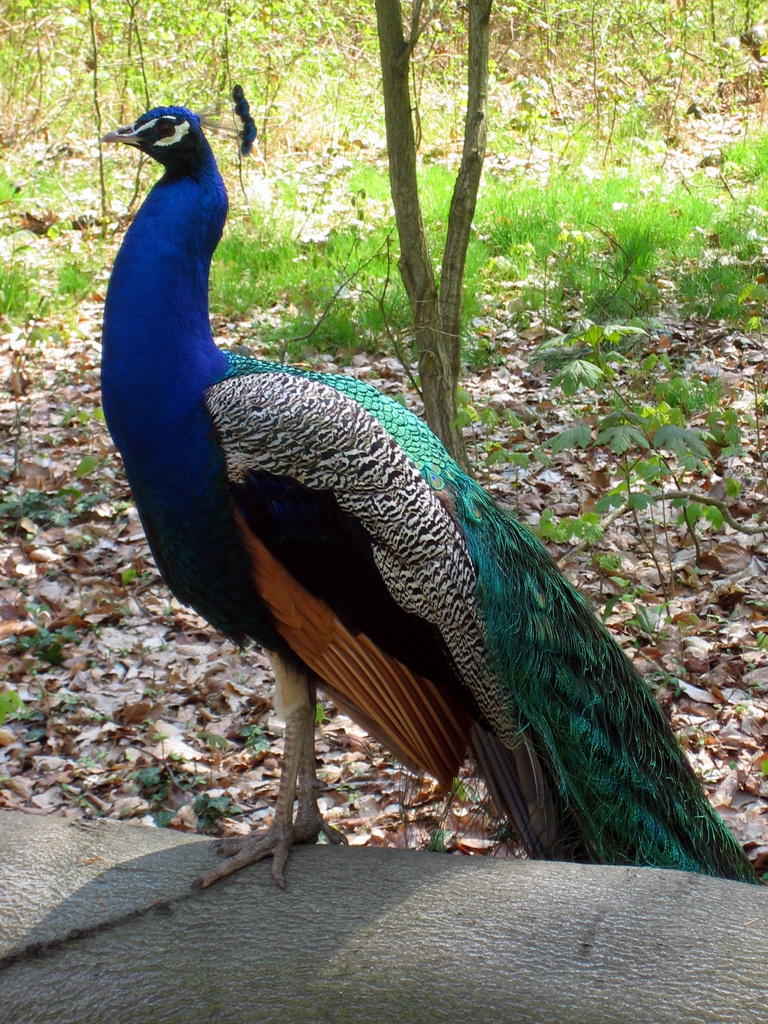Indian Peafowl (Pavo cristatus) - Wiki Indian Peafowl
From Wikipedia, the free encyclopedia
[Photo] Indian Peafowl (Pavo cristatus) adult male. Photo by Bautsch. public domain
The Indian Peafowl, Pavo cristatus also known as the Common Peafowl or the Blue Peafowl is one of the species of bird in the genus Pavo of the Phasianidae family known as peafowl. The Indian Peafowl is a resident breeder in the Indian subcontinent. The peacock is the national bird of India.
The species is found in dry semi-desert grasslands, scrub and deciduous forests. It forages and nests on the ground but roosts on top of trees. It eats mainly seeds, but also some insects, fruits and reptiles.
Females are about 86 cm (34 in) long and weigh about 3.4 kg (7.4 lbs), while males average at about 2.12 m (7.3 ft) in full breeding plumage (107 cm/42 in when not) and weigh about 5 kg (11 lbs). The male is called a peacock, the female a peahen. The Indian Peacock has iridescent blue-green plumage. The upper tail coverts on its back are elongated and ornate with an eye at the end of each feather. These are the Peacock's display feathers. The female plumage is a mixture of dull green, grey and iridescent blue, with the greenish-grey predominating. In the breeding season, females stand apart by lacking the long 'tail feathers' also known as train, and in the non-breeding season they can be distinguished from males by the green colour of the neck as opposed to the blue on the males.
Peafowl are most notable for the male's extravagant display feathers, despite actually growing from their back is known as a 'tail' and also known as a train, a result of sexual selection, which it displays as part of courtship. This train is in reality not the tail but the enormously elongated upper tail coverts. The tail itself is brown and short as in the peahen.
They lay a clutch of 4-8 eggs which take 28 days to hatch. The eggs are light brown and are laid every other day usually in the afternoon. The male does not assist with the rearing, and is polygamous with up to six hens.
Mutations
Peafowl are sometimes kept as domesticated animals for decoration. Many genetic mutations exist, such as the Black-Shouldered, Oaten, White, White-Eyed, Purple, Opal, Pied, and Midnight.
The "Black-Shouldered" mutant was originally thought to be a distinct subspecies, Pavo cristatus nigripennis.
The White Peafowl is often mistaken for an albino, but its iris is dark, not red, and is a recessive mutation.
Hybridization and concerns
The Indian Peafowl can hybridise with the closely related Green Peafowl, Pavo muticus, in captivity and creates offspring called "Spauldings" or "Spaldings". The original "Spalding" was a hybrid between a female of the Black-Shouldered mutation of the Indian Peafowl, with a male of the nominate Java subspecies of the Green Peafowl, though some believe it was really a cross between a Black-Shouldered male with a Green Peafowl hen of the subspecies imperator.
Even though there is no natural range overlap, hybridization occurs in the wild when feral populations of one of the species overlaps another species. Hybridization has created some concern as the Green Peafowl is endangered.
Indian Peafowl and humans
In the Middle Ages, the flesh of the Indian Peafowl was highly prestigious and believed to be imperishable. Thanks to its reputation of being immortal it was also a symbol of the Catholic church. Though its meat is tough and not well-suited for consumption, it was prized due to being a luxury and often domesticated for human consumption by the medieval nobility and was often served at banquets as a subtlety. This was usually done by skinning the bird, cooking, grinding up and seasoning the flesh, and then redressing it in its own plumage and serving it in a lifelike pose by bracing it with wooden struts. It was also common to discard the meat and stuff the colorful plumage with the meat of tastier domestic fowl such as goose or chicken to please and entertain diners.
Indian Peafowl as pets
Indian Peafowl can be companion animals but there may be problems with dogs, cats and other pets. They may roam, roost or mess on adjoining property. Peafowl have been called "urban guard dogs" because their distinctive cries can act as a warning of approaching people. Several British stately homes keep peafowl in the grounds.
...
http://en.wikipedia.org/wiki/Indian_Peafowl
| The text in this page is based on the copyrighted Wikipedia article shown in above URL. It is used under the GNU Free Documentation License. You may redistribute it, verbatim or modified, providing that you comply with the terms of the GFDL. |
